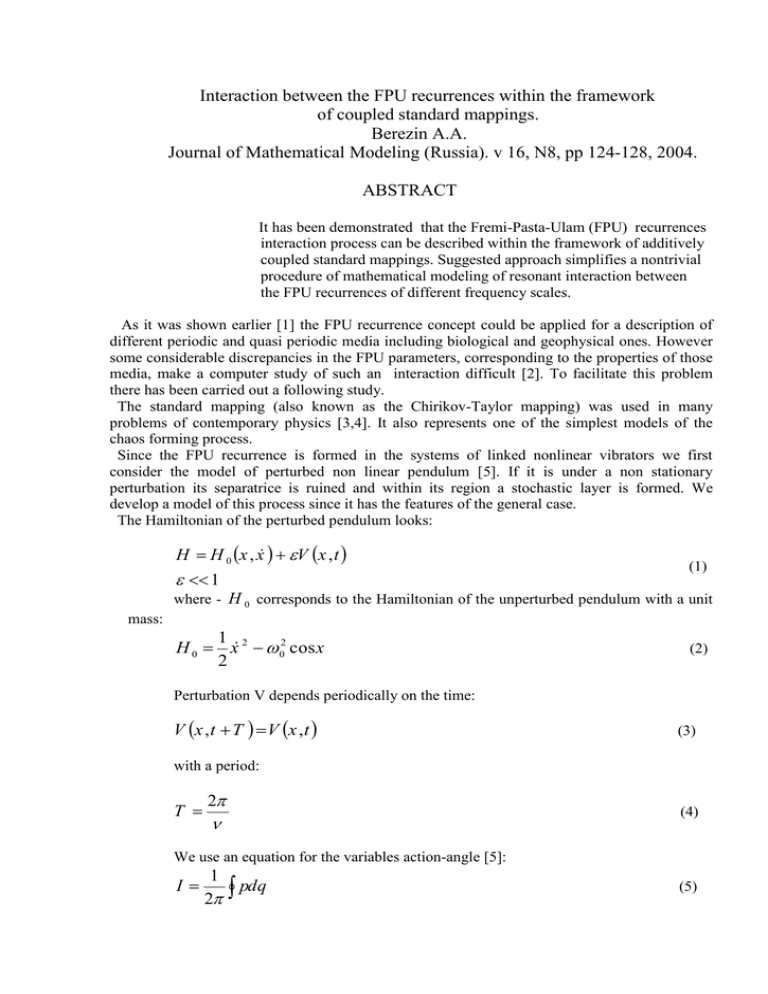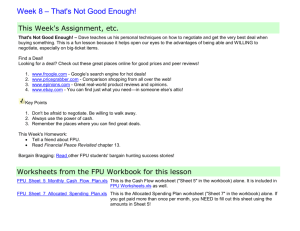berezin.framework.doc
advertisement

Interaction between the FPU recurrences within the framework of coupled standard mappings. Berezin A.A. Journal of Mathematical Modeling (Russia). v 16, N8, pp 124-128, 2004. ABSTRACT It has been demonstrated that the Fremi-Pasta-Ulam (FPU) recurrences interaction process can be described within the framework of additively coupled standard mappings. Suggested approach simplifies a nontrivial procedure of mathematical modeling of resonant interaction between the FPU recurrences of different frequency scales. As it was shown earlier [1] the FPU recurrence concept could be applied for a description of different periodic and quasi periodic media including biological and geophysical ones. However some considerable discrepancies in the FPU parameters, corresponding to the properties of those media, make a computer study of such an interaction difficult [2]. To facilitate this problem there has been carried out a following study. The standard mapping (also known as the Chirikov-Taylor mapping) was used in many problems of contemporary physics [3,4]. It also represents one of the simplest models of the chaos forming process. Since the FPU recurrence is formed in the systems of linked nonlinear vibrators we first consider the model of perturbed non linear pendulum [5]. If it is under a non stationary perturbation its separatrice is ruined and within its region a stochastic layer is formed. We develop a model of this process since it has the features of the general case. The Hamiltonian of the perturbed pendulum looks: H H 0 x , x V x , t 1 (1) where - H 0 corresponds to the Hamiltonian of the unperturbed pendulum with a unit mass: 1 H 0 x 2 02 cos x 2 (2) Perturbation V depends periodically on the time: V x , t T V x , t (3) with a period: T 2 (4) We use an equation for the variables action-angle [5]: I 1 pdq 2 (5) where p pq , H Using (5) we can substitute the variable and transfer from (х,х) to (I, ) in the following way: I 1 1 2 2 , dqp q , H p q , H 2 H cos x 0 0 0 0 2 (6) This substitution allows to modify the initial Hamiltonian (1) as follows: H H 0 I V I , , t (7) The Hamiltonian that gives the standard mapping looks like: 1 2 H I K cos t n T 2 n (8) Eq. (8) describes a system with an unperturbed Hamiltonian: 1 H0 I 2 2 (9) which is under the influence of a periodicity of pushes ( - pulses ) with a period: T 2 (10) Accounting the equality: t T n cos2nt T n n (11) the Hamiltonian (8) can be overwritten as follows: 1 H I 2 K cos cosm t 2 m (12) As it can be concluded from Eq.(12) it corresponds to the motion of a particle in a periodical wave packet having an infinite number of harmonics with equal amplitudes. The motion equations from (8) look like: (13) I const , It const (14) I K sin tT n n , I between the two δ - functions when overtaking δ – function the variable θ remains continuous and the action I is changed by K sin . If to accept that (I, θ) – are the variable meanings preceding the n-th push and (I, θ) – are their meanings before the next (n+1)-th push, from (13) there follows the mapping: I I K sin , I mod 2 (15) The mapping (15) substitutes the equations of motion (13). To apply the standard mapping (15) to the description of the FPU recurrence dynamics we have to represent the canonical FPU chain [6] through a different – differential equation of a nonlinear pendulum equation: (16) x 02 sin x 0 In the simplest case the Eq. (16) can be substituted: x n 1 2 x n x n 1 02 t sin x n 0 2 (17) where Δt –is the time interval represents an elementary step of the difference scheme and x n x nt (18) if K 0 t 1 2 and Pn 2 1 x n x n1 t (19) (20) The Equations (6) и (9) can be overwritten as a following coupled system: Pn 1 Pn 02 t sin x n x n 1 x n tPn 1 (21) In the system (21) the Eq(19) was used. The mapping (21) represents the standard mapping. The phase space of (16) consists only of the invariant curves whereas the phase space of the system (21) has an unlimited number of stochastic layers under arbitrary small К. A transition to the discrete equation is equivalent to adding of the external periodical force. Worth mentioning that the mapping (21) is generated by the Hamiltonian (8) in which I = рΔt, θ = х, that is: 1 2 2 H p 0 cos x cosm t 2 m where 2 t (22) Accounting inequality (19) we’ll take in (22) only members with m = 0,+1. It brings to the following Hamiltonian: H H 0 V discr (23) where- H 0 P 2 2 02 cos x , V discr 2 02 cos x cost (24) As it can be seen from Eqs (23,24) the Hamiltonian Н corresponds to the initial Eq (16), and Vdiscr -is the perturbation potential, stipulated by the discretization. This potential causes a stochastic layer formation with the following width [5]: 2 E 4 2 exp E s 02 2 0 t 0 t E (25) Eq.(25) gives a qualitatively new feature of discretization. Its potential Vdiscr is a high frequency one ( 0 ), but its amplitude has the same order as that of a non perturbed potential. All corrections due to Vdiscr are small as well as the corrections of high frequency perturbations. However this statement remains just only for the invariant curves perturbations located far from the separatrices. Within the vicinity of them the influence of Vdiscr brings to the qualitatively new dynamics- namely to the stochastic instability. Since the FPU recurrence demonstrates a transition to stochasticity [7] the standard mapping (21) and Eq.(25) correspond to the dynamics of the canonical FPU chain [6]. Such a representation of the FPU recurrence opens a new possibility - that is modeling of a resonant interaction between incompatible by their parameters FPU recurrences. Previous study of this problem [2] showed that such a parameter discrepancy between the interacting FPU recurrences results in a non triviality of the computer study of the problem. In particular such different recurrences can interact only through their stochasticities and during the calculations it often leads to the blowing up of the computer program. The standard mapping approach provides “slicing” of calculations and even allows to visualize the process of interaction. The proposed approach can be used for example in case of the study of interaction between human heart beating process (mean frequency 1Hz) and the earth seismic activity (11 years 10 10 Hz). The heart beat rhythm has a typical FPU dynamics whose stochastic part appears in the phase distribution of the Fourier sequence of the electrocardiographic patterns. The earth seismicity patterns also represent the FPU dynamics with a stochastic part. On the other hand the problem of interaction between the stochastic part of the seismic dynamics and random event generators readings is as well on the agenda. So to facilitate modeling of the above mentioned problems the standard mapping approach can suggest a simple additive coupling of two mappings. To study this we’ll overwrite the standard mapping (21) into the form that corresponds to the spatial pendulum: Pn 1 Pn k 02 Z sin x n x n 1 x n ZP n 1 (26) where ΔZ – is the parameter of the space discretization . Accounting (25) and (15) we can write down two additively coupled high frequency and low frequency standard mappings in a form: k Bi 1 k Bi k Hi K sin Bi ; Bi 1 Bi k Bi k Hi 1 k Hi k Bi K sin Hi Hi 1 Hi k Hi (27) where k H i andk Bi - are the effective special frequencies between the pushes in the high and low frequency standard mappings correspondingly. The results of the computer study of Eq.(27) are given below Fig.1.Computer solution of Eq.(27) when Bi varies from 0 to 300. Fig.2.Computer solution of Eq.(27) when Bi varies from 300 to 600. Fig.3.Computer solution of Eq.(27) when Bi varies from 600 to 900. Fig.4.Computer solution of Eq.(27) when Bi varies from 900 to 1200. As it can be seen from the graphs the low frequency FPU recurrence dominates in the process by its amplitude whereas the high frequency FPU recurrence qualitatively changes the phase parameters of the low frequency FPU spectrum dynamics. So there always exists a resonant interaction between any FPU recurrences despite any difference in their frequency scales for example between biological and geophysical dynamics interpreted as FPU recurrences. References 1.Berezin.A.A. Coherent and stochastic properties of physical and biological systems. Moscow, 2003.(in Russian) 2.Berezin.A.A. Resonant interaction between the Fermi-Pasta-Ulam recurrences. Bulletin of the Lebedev Physics Institute.(Russian Academy of Sciences).n 3, 2004, p 41-50.Allerton Press N.Y. 3.Menyuk.C.R. Phys. Rev.- 1985.-V. A31.-p 3282. 4. Lichtenberg. A. J. and M.A.Lieberman.// Appl. Math. Sci.v 38. SpringerVerlag .1991.p 450 - 469. 5.Zaslavsy.G.M, Sagdeev.R.Z.,Usikov.D.A.,Chernikov.A.A.Weak Chaos and QuasiRegular Patterns.Moscow.Nauka.1991. 6. Fermi E., Pasta J., and Ulam S. In: Collected Papers of E. Fermi. 1955. Vol. 2, p. 978. 7.Izrailev F. M. and Chirikov. B. V. Soviet. Phys Dokl., 1966. 11, 30.




